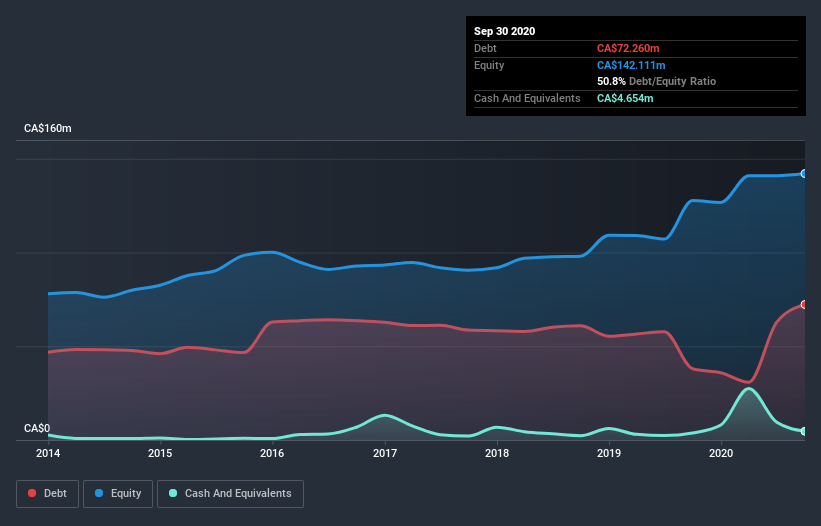Does Richards Packaging Income Fund (TSE:RPI.UN) Have A Healthy Balance Sheet?

The external fund manager backed by Berkshire Hathaway's Charlie Munger, Li Lu, makes no bones about it when he says 'The biggest investment risk is not the volatility of prices, but whether you will suffer a permanent loss of capital.' When we think about how risky a company is, we always like to look at its use of debt, since debt overload can lead to ruin. Importantly, Richards Packaging Income Fund (TSE:RPI.UN) does carry debt. But should shareholders be worried about its use of debt?
Why Does Debt Bring Risk?
Generally speaking, debt only becomes a real problem when a company can't easily pay it off, either by raising capital or with its own cash flow. If things get really bad, the lenders can take control of the business. While that is not too common, we often do see indebted companies permanently diluting shareholders because lenders force them to raise capital at a distressed price. Of course, plenty of companies use debt to fund growth, without any negative consequences. The first step when considering a company's debt levels is to consider its cash and debt together.
Check out our latest analysis for Richards Packaging Income Fund
How Much Debt Does Richards Packaging Income Fund Carry?
As you can see below, at the end of September 2020, Richards Packaging Income Fund had CA$66.2m of debt, up from CA$38.0m a year ago. Click the image for more detail. On the flip side, it has CA$4.65m in cash leading to net debt of about CA$61.5m.

How Healthy Is Richards Packaging Income Fund's Balance Sheet?
We can see from the most recent balance sheet that Richards Packaging Income Fund had liabilities of CA$115.7m falling due within a year, and liabilities of CA$71.9m due beyond that. Offsetting this, it had CA$4.65m in cash and CA$52.5m in receivables that were due within 12 months. So its liabilities total CA$130.4m more than the combination of its cash and short-term receivables.
Since publicly traded Richards Packaging Income Fund shares are worth a total of CA$754.1m, it seems unlikely that this level of liabilities would be a major threat. However, we do think it is worth keeping an eye on its balance sheet strength, as it may change over time.
In order to size up a company's debt relative to its earnings, we calculate its net debt divided by its earnings before interest, tax, depreciation, and amortization (EBITDA) and its earnings before interest and tax (EBIT) divided by its interest expense (its interest cover). This way, we consider both the absolute quantum of the debt, as well as the interest rates paid on it.
Richards Packaging Income Fund's net debt is only 0.70 times its EBITDA. And its EBIT covers its interest expense a whopping 25.0 times over. So you could argue it is no more threatened by its debt than an elephant is by a mouse. On top of that, Richards Packaging Income Fund grew its EBIT by 88% over the last twelve months, and that growth will make it easier to handle its debt. When analysing debt levels, the balance sheet is the obvious place to start. But ultimately the future profitability of the business will decide if Richards Packaging Income Fund can strengthen its balance sheet over time. So if you want to see what the professionals think, you might find this free report on analyst profit forecasts to be interesting.
But our final consideration is also important, because a company cannot pay debt with paper profits; it needs cold hard cash. So we always check how much of that EBIT is translated into free cash flow. During the last three years, Richards Packaging Income Fund produced sturdy free cash flow equating to 73% of its EBIT, about what we'd expect. This free cash flow puts the company in a good position to pay down debt, when appropriate.
Our View
Happily, Richards Packaging Income Fund's impressive interest cover implies it has the upper hand on its debt. And that's just the beginning of the good news since its EBIT growth rate is also very heartening. Overall, we don't think Richards Packaging Income Fund is taking any bad risks, as its debt load seems modest. So we're not worried about the use of a little leverage on the balance sheet. When analysing debt levels, the balance sheet is the obvious place to start. But ultimately, every company can contain risks that exist outside of the balance sheet. For instance, we've identified 2 warning signs for Richards Packaging Income Fund that you should be aware of.
When all is said and done, sometimes its easier to focus on companies that don't even need debt. Readers can access a list of growth stocks with zero net debt 100% free, right now.
When trading Richards Packaging Income Fund or any other investment, use the platform considered by many to be the Professional's Gateway to the Worlds Market, Interactive Brokers. You get the lowest-cost* trading on stocks, options, futures, forex, bonds and funds worldwide from a single integrated account. Promoted
New: AI Stock Screener & Alerts
Our new AI Stock Screener scans the market every day to uncover opportunities.
• Dividend Powerhouses (3%+ Yield)
• Undervalued Small Caps with Insider Buying
• High growth Tech and AI Companies
Or build your own from over 50 metrics.
This article by Simply Wall St is general in nature. It does not constitute a recommendation to buy or sell any stock, and does not take account of your objectives, or your financial situation. We aim to bring you long-term focused analysis driven by fundamental data. Note that our analysis may not factor in the latest price-sensitive company announcements or qualitative material. Simply Wall St has no position in any stocks mentioned.
*Interactive Brokers Rated Lowest Cost Broker by StockBrokers.com Annual Online Review 2020
Have feedback on this article? Concerned about the content? Get in touch with us directly. Alternatively, email editorial-team@simplywallst.com.
About TSX:RPI.UN
Richards Packaging Income Fund
Designs, manufactures, and distributes packaging containers and healthcare supplies and products in North America.
Flawless balance sheet established dividend payer.
Market Insights
Community Narratives



